255–256 Upper Street, Islington, London, N1 1RY
This pub backs onto Swan Yard, the remaining part of a much larger yard, belonging to the Old White Swan. The Old White Swan, demolished in the 1960s, stood next to the post office, separated from Club Union House by the railway station.
A framed collection of illustrations and text about The White Swan.
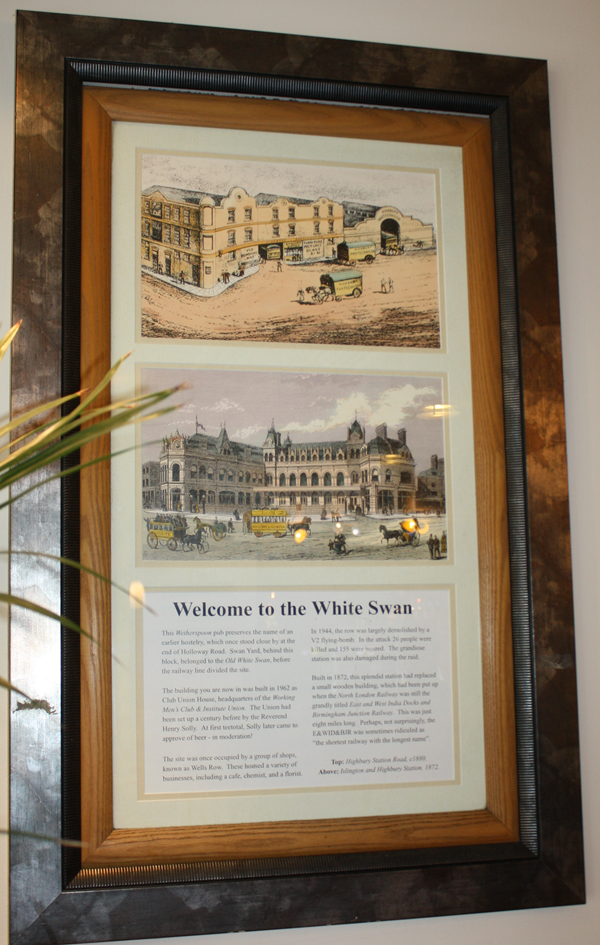
The text reads: This Wetherspoon pub preserves the name of an earlier hostelry, which once stood close by at the end of Holloway Road. Swan Yard, behind this block, belonged to the Old White Swan, before the railway line divided the site.
The building you are now in was built in 1962 as Club Union House, headquarters of the Working Men’s Club & Institute Union. The Union had been set up a century before by the Reverend Henry Solly. At first teetotal, Solly later came to approve of beer – in moderation!
The site was once occupied by a group of shops, known as Wells Row. These housed a variety of businesses, including a cafe, chemist, and a florist.
In 1944, the row was largely demolished by a V2 flying-bomb. In the attack 26 people were killed and 155 were injured. The grandiose station was also damaged during the raid.
Built in 1872,this splendid station replaced a small wooden building, which had been put up when the North London Railway was still the grandly titled East and West India Docks and Birmingham Junction Railway. This was just eight miles long. Perhaps, not surprisingly, the E&WID&BJR was sometimes ridiculed as “the shortest railway with the longest name”.
Top: Highbury Station Road, c.1880
Above: Islington and Highbury Station, 1872.
A framed collection of prints, illustrations and text about literary locals.
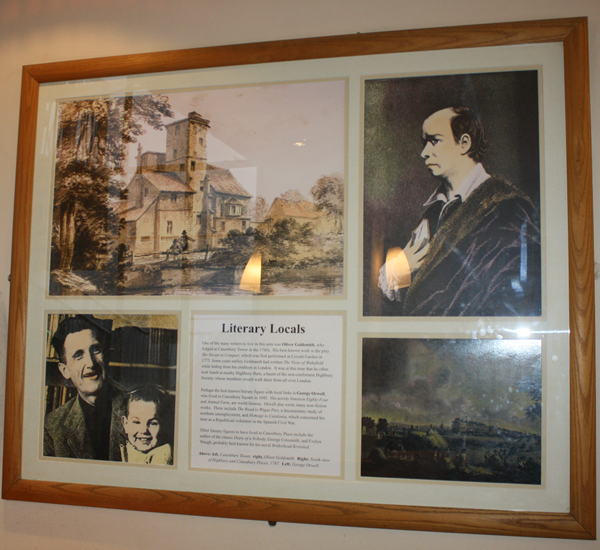
The text reads: One of the many writers to live in this area was Oliver Goldsmith, who lodged at Canonbury Tower in the 1760s. His best-known work is the play She Stoops to Conquer, which was first performed at Covent Garden in 1773. Some years earlier, Goldsmith had written The Vicar of Wakefield while hiding from his creditors in London. It was at this time that he often took lunch at nearby Highbury Barn, a haunt of the non-conformist Highbury Society, whose members would walk there from all over London.
Perhaps the best known literary figure with local links is George Orwell, who lived in Canonbury Square in 1945. His novels Nineteen Eighty-Four and Animal Farm, are world famous. Orwell also wrote many non-fiction works. These include the Road to Wigan Pier, a documentary study of northern unemployment, and Homage to Catalonia, which concerned his time as a Republican volunteer in the Spanish Civil War.
Other literary figures to have lived in Canonbury Place include the author of the classic Diary of a Nobody, George Crossmith, and Evelyn Waugh, probably best known for his novel Brideshead Revisited.
Above: left, Canonbury Tower, right, Oliver Goldsmith. Right: North view of Highbury and Canonbury Places, 1787. Left: George Orwell.
A framed collection of drawings and text about Laycocks Farm.

The text reads: The name of nearby Laycock Street is all that remains of Islington’s largest farm. The farm was established by Charles Laycock, replacing many of the older small dairy farms. It was situated on the route into London for animals being herded for sale at Smithfield, so Laycock obtained payment for holding animals overnight, or for longer if they needed fattening.
In the 1800’s Laycock’s farm had a herd of over 600 cattle, and 100 horses with carts, mainly for transporting cattle-feed. 500 cows were milked in the early hours each morning. His premises extended from Upper Street to Liverpool Road and included loose boxes, stables, barns, cowhouses, crop storehouses, grain pits, blacksmiths’, wheelwrights’, and carpenters’ shops, timber yard and sawpits. On the west side of Liverpool Road he owned houses and some building land used as sheep pens in 1835. Laycock died in 1834 after 40 years in business. In 1841 the occupier of Laycock’s farm had six cowsheds’ each with 54 cows, and pens with 5,000 sheep.
Above left: Laycock’s farm stables off Liverpool Road, c. 1890
Left: Laycock’s Dairy in the mid-1800’s
Right: Inside Laycock’s dairy, c. 1850
A framed collection of drawings and text about entertainers from the area.
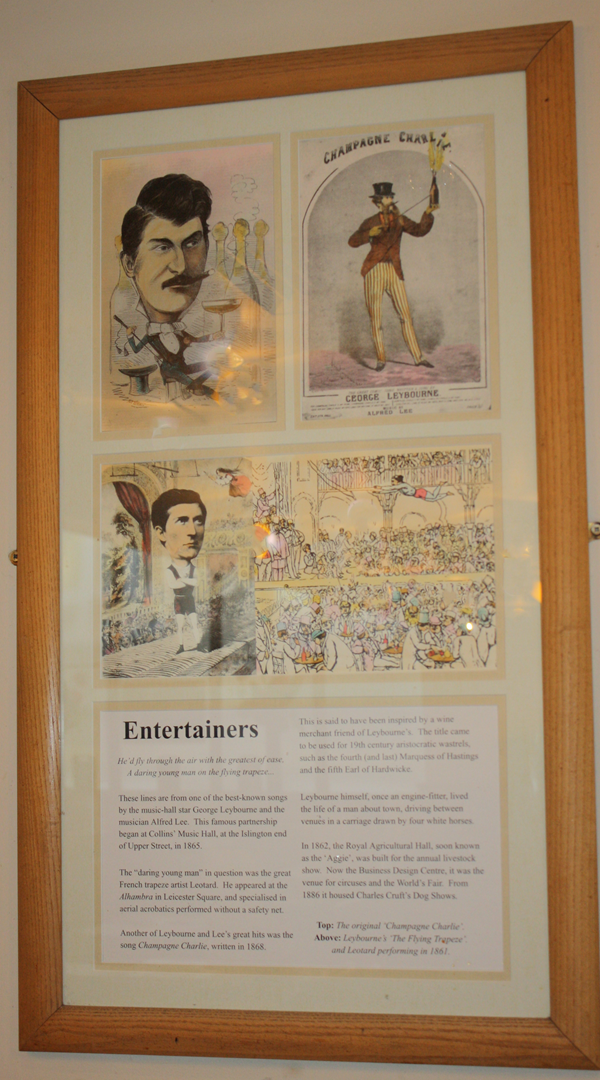
The text reads:
He’d fly through the air with the greatest of ease. A daring young man on the flying trapeze…
These lines are from one of the best-known songs by the music-hall star George Leybourne and the musician Alfred lee. This famous partnership began at Collins’ Music Hall, at the Islington end of Upper Street, in 1865.
The “daring young man” in question was the great French trapeze artist Leotard. He appeared at the Alhambra in Leicester Square, and specialised in aerial acrobatics performed without a safety net.
Another of Leybourne and Lee’s great hits was the song Champagne Charlie, written in 1868.
This is said to have been inspired by a wine merchant friend of Leybourne’s. The title came to be used for 19th century aristocratic wastrels, such as the fourth (and last) Marquess of Hastings and the fifth Earl of Hardwicke.
Leybourne himself, once an engine-fitter, lived the life of a man about town, driving between venues in a carriage drawn by four white horses.
In 1862, the Royal Agricultural Hall, soon known as the ‘Aggie’, was built for the annual livestock show. Now the Business Design Centre , it was the venue for circuses and the World’s Fair. From 1886 it housed Charles Cruft’s Dog Shows.
Top: The original ‘Champagne Charlie’.
Above: Leybourne’s ‘The Flying Trapeze’, and Leotard performing in 1861.
A framed collection of drawings and photographs of Canonbury Tower.
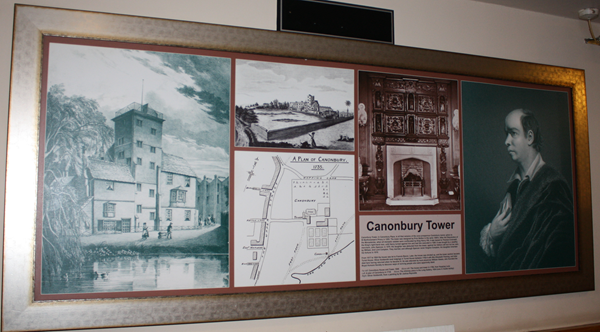
A framed collection of illustrations and text about White Conduit House.
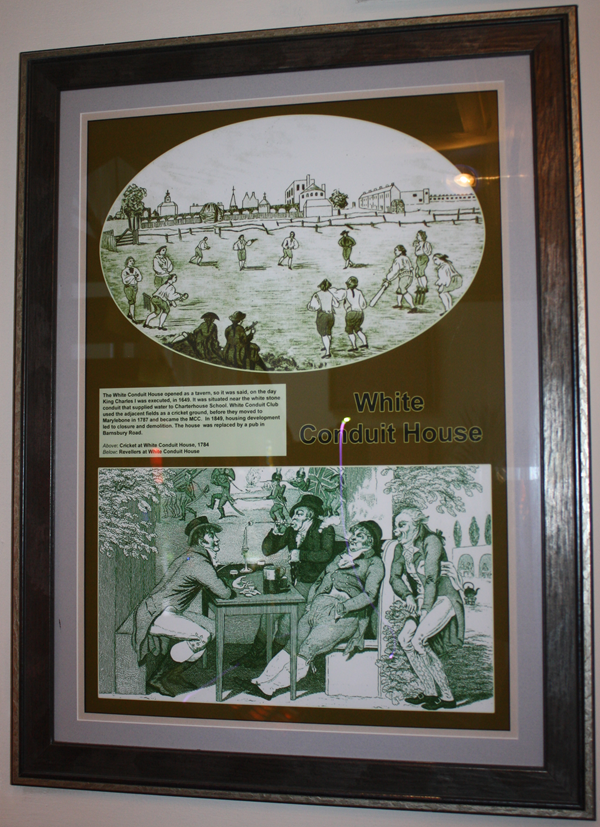
The text reads: The White Conduit House opened as a tavern, so it was said, on the day King Charles I was executed, in 1649. It was situated near the white stone conduit that supplied water to Charterhouse School. White Conduit Club used the adjacent fields as a cricket ground, before they moved to Marylebone in 1787 and became the MCC. In 1849, housing development led to closure and demolition. The house was replaced by a pub in Barnsbury Road.
Above: Cricket at White Conduit House, 1784
Below: Revellers at White Conduit House.
Framed illustrations and text about The Favorites.

The text reads: Before the First World War, nearby Laycock Street was known for some time as Wilson Street. The name came from Elizabeth and John Wilson, who had taken over some of the outbuildings of Laycock’s Farm for stabling the horses of their bus company.
The company had outgrown its first site, on Holloway Road. The Wilsons had begun there in 1830, with two 12-seater coaches.
The company continued to prosper, and by 1856 had become the city’s biggest bus company, with 500 horses available to haul 48 coaches. The whips and drivers wore smart green livery with brass buttons.
Each year on Queen Victoria’s birthday, John Wilson drove one of his buses at the head of a procession of his employees and a band, and led them to a staff banquet at an inn in Hrnsey Road.
Wilson’s buses bore the name Favorite on the side. This was not a mis-spelling, but in imitation of a Parisian bus company. The French connection continued even after they sold their business to the London General Omnibus Company, which was a French-owned firm.
Wilson continued with the company as district manager. A coach-building department was set up, and made horse-bus bodies until the early 1900s. “Wilson’s Yard” later became a public street.
Top: The Favorites.
Above: The bus depot, later Laycock Street.
A framed photograph of Upper Street, Islington c1924.

A framed photograph of the horse-drawn engines of Islington Fire Brigade, in c1905.

Swan Yard, which belonged to the Old White Swan.

External photograph of the building – main entrance.
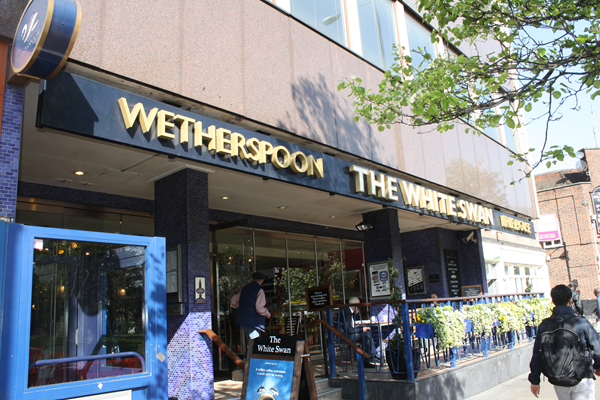
If you have information on the history of this pub, then we’d like you to share it with us. Please e-mail all information to: pubhistories@jdwetherspoon.co.uk